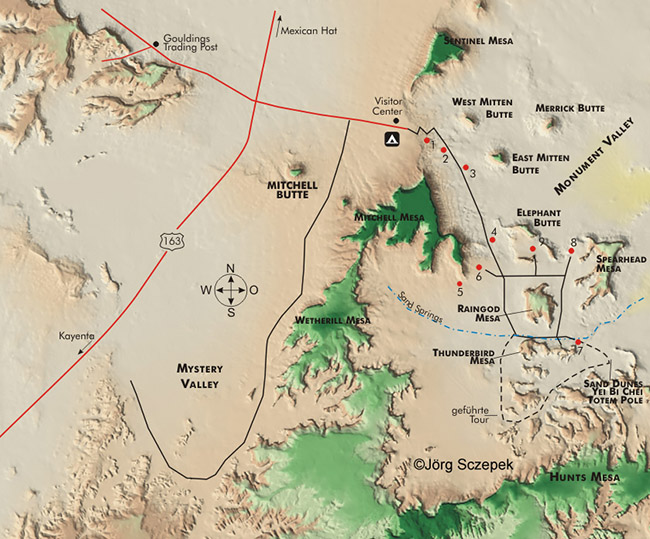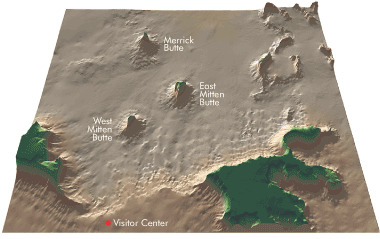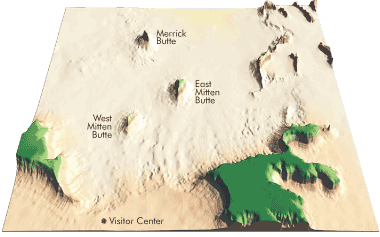- At 1697 m (5,567 ft) altitude
- Close to 400.000 visitors per year
How, Where, What
A cinemascope-wide valley, three mighty red sandstone towers, above them an infinitely blue sky. What more does it take to make a movie set – a magnificent picture – a place of longings and desires? But Monument Valley is not all dreams; it has a real side, too: it is a tribal park, administered by the Navajos, whose members still live in the valley by raising sheep and goats.
On the present valley floor and far beyond, a few million years ago, there was a massive mesa, higher than the buttes (pronounced „Bjutes„) still standing. But thanks to the perpetual processes of erosion, all that remains of it are the colossal witness mountains, of which West Mitten Butte, East Mitten Butte, and Merrick Butte dominate the landscape at more than 350 m (1,148 ft) high.
The commercialization of the valley has increased enormously in recent years – don’t be surprised to find souvenir booths at many viewpoints!
Directions
Monument Valley is located on Rt-163 midway between Kayenta and Bluff (70 km / 45 mi each) and half each in Arizona and Utah. You’ll experience the classic view of the dead-straight road leading toward the monuments piercing the horizon as you approach via Rt-163 from Mexican Hat.
There is a visitor center at the edge of the valley with a simple campground attached. Gouldings Trading Post, located 5 km (3 mi) away on the other side of Rt-163, offers a motel with a campground and a well-stocked supermarket.
Special consideration applies to the valley as a tourist hotspot, as most of the land is private property. Therefore, only a 27 km (17 mi) circuit of the Self-Guided Drive (1.5-2 hours) is open to private traffic for vehicles up to a maximum of 27 ft in length, which unfortunately excludes the most interesting parts of the landscape. It is open between May and September from 06:00-20:30. From October to April, shortened hours apply between 08:00-16:30.
Only when accompanied by a Navajo guide can you access the larger portion, the most exciting formations, and the Native American ruins and artifacts. Such an organized tour in a 4WD vehicle is recommended due to the poor dirt roads. The duration of the guided tours varies from 1.5 hours to a full day. They offer the possibility to see Indian ruins, demonstrations of local handicrafts or posed performances in original costumes in front of the lens. Their disadvantage is that they often offer little time for photography and do not always arrive with the best light. Tours depart from the Visitor Center, Gouldings Trading Post, and the towns of Bluff, Mexican Hat and Kayenta. There is little room for a tripod on the bus, so take a flash instead to photograph inside the traditional hogans. If you want to enter the park at sunrise or have more time to photograph in otherwise inaccessible places, you’ll need to place yourself in the care of a private guide at the Visitor Center. If you pay by the hour, he will take you to all the formations in his jeep, and you can, of course, stay as long as you want. Expect to pay an hourly rate of $ 50. Thanks to tighter restrictions, even guided group tours are no longer allowed into Monument Valley outside of regular Self-Guided Drive hours. For photography, this is a serious disadvantage in terms of lighting conditions.

Geographical orientation and the most photogenic times of day
The valley and the three major buttes stretch west-east from the Visitor Center, allowing them to intersect with the sunrise. The best times to work the camera are early morning and late afternoon. In the morning, the sky is clear, the light is cool, and the backlighting creates a rarely seen image of the monuments. In the afternoon, on the other hand, the light is warmer and there is often a bit of haze. Around midday and even earlier, it’s best to work with the sun. Artists Point, and even better, North Window, and the short path leading from there to the right are ideal for this. From this location, you can explore various viewpoints and capture a multitude of compelling foreground objects. Plus, you have the opportunity to photograph the monuments from a perspective that has not yet been overphotographed. Since there are photo opportunities from both long and short distances, you should pack focal lengths ranging from wide angle to light telephoto.



Minimum program and daily schedule
3 hours in the afternoon to cover the Self-Guided Drive and take in the panorama of the monuments from the height of the Visitor Center at sunset. However, to take in all the main parts of the park in good light, you will need a whole day. Then you do the Self Guides Drive in the morning and take a guides tour in the afternoon.
Motifs along the Self-Guided Drive
The view from the Visitor Center is impressive at any time of day, especially when set against a slightly cloudy sky. Sunrise and sunset are spectacular. Then the buttes are silhouetted against the sun and a first purple, later red sky or are bathed in liquid gold by the light. Focal lengths of 35 mm and less are adequate. Be here at least 30 min before sunrise to capture the first reddish reflection in the eastern sky. When this effect becomes stronger, orient the exposure to the brightest part of the sky, but vary it by +/- 2/3 stops. The hill of the Visitor Center casts a black shadow on the base of the buttes, increasing the contrast. The image becomes even more impressive after the first two switchbacks on the way down the valley. Photographers can capture the three buttes several times a day in varying light conditions, combining the images into a fade sequence. In the morning, the rock seems to glow; in the afternoon, the buttes stand as a dark silhouette.
Marker # 1: from here, the three buttes appear a bit larger, since the horizon is lower here and you are closer to them than at the level of the visitor center.
Marker # 2: provides another view of the three buttes; the dead tree gives a good frame for wide-angle compositions with Merrick Butte.
Marker # 3: is one of the best stops in the valley, and you should return several times a day if possible, as the changing light always yields new images. To the left below is a natural pool of water, which, if filled, you can use for reflections of West Mitten Butte. You should do this in the morning when the sun is not in your field of view. Another dead tree sits on the hill to the right, perfectly positioned to frame West Mitten.
Marker #4/Elephant Butte: The formation resembling an elephant lies just ahead. The flat afternoon light accentuates the shape, making it easier to see.
Marker # 5/The Three Sisters: The three pointed sandstone ridges, located halfway to the right from Elephant Butte View, are best photographed with a light telephoto.
Marker #6/John Ford’s Point: This location provides a closer look at the Three Sisters, as well as a side view of two of the three large monuments. In the morning, work with the light here while a backlight situation presents itself in the afternoon. Between 9:30 and 10:00 and between 14:00 and 14:30, an Indian on horseback poses on a rock ledge for the guided tours.
Marker #7/Sand Springs: provides a clear view of the Totem Pole and a section of the sand dunes, an area of the valley that requires a guided tour for closer exploration. This location is ideal for morning and afternoon photography, with a focal length of approximately 180 mm. Sand Springs is the valley’s main water source, and if you’re lucky, you’ll see Indian shepherds herding their sheep here to water in the late afternoon.
Marker #8/Artists Point: offers a spectacular panorama from the side over the broad valley and the three monuments. Given that the view is to the north, the morning is just as spectacular as the afternoon, as the light from the side accentuates the vastness with beautiful contrasts. Then, when there are some clouds texturing the sky, which is often the case in the second half of the day, you can’t beat it.
Marker #9/North Window: is also a good location for the flatter afternoon light. It’s not easy to get the rock opening in the picture with a wide angle, but the farther back you go to the south, toward Raingod Mesa, the better you can condense the view with a telephoto. You can even include the tree in the middle of the parking area. Looking to the left from the parking area, the Three Sisters are in a different perspective than at John Ford Point. At the end of the dirt road, follow the side trail to the right around Cly Butte for a wide panorama of the distant Buttes with East Mitten in the foreground.
When visiting, keep in mind that clocks within the Navajo Reservation are set back one hour due to daylight saving time. This is not the case in the rest of Arizona.
Motifs on the guided tours
Yei Bi Chei and Totem Pole: Only with a guide will you get to this area for the sunrise, and you’ll really miss out if you skip it. From the east side of Raingod Mesa, you can first place the rising sun behind the peaks of Yei Bi Chei and Totem Pole. A super wide angle captures much of the colorful sky, and with 180 mm focal length, you condense the formations. 1 mile further through Sand Springs Wash, you’ll head straight into the dune field for a classic view of the sand dunes neatly furrowed by the wind against the glowing red rock towers. Even in the flat afternoon light, the dunes once again reveal their luminosity, so even late risers can get a good shot. You can’t see the dunes from the vantage point on the Self Guided Drive, but with a telephoto, you can at least get Yei Bi Chei in the picture.
The Hotcake Flats are rippled rock formations that resemble pancakes.
Suns Eye is an opening in a sandstone wall. Nearby are also petroglyphs, wonderfully detailed representations of animals and human creatures carved into the dark rock.
Ear of the Wind is a beautiful blue opening in the red sandstone, with green vegetation in the foreground.
The vicinity of Echo Cave Ruin is home to excellent petroglyphs. The blue-green plants are Loco Weeds, which contrast well with the red soil. Additionally, there is usually a stop at a traditional hogan where you have the opportunity to look over the shoulders of the Navajos as they weave. For shots in the dark interior of the round hut, be sure to carry a flash.
Teardrop Window is a wonderful subject, and its name says it all. It is located above the high school building on the spur road to the Gouldings Trading Post and looks east toward the Monument Valley formations. Access is via a dusty road that requires 4WD. During the summer, it is front-lit by the sun low in the west around 17:30 (1 hour earlier in the fall), so it´s shape in the red rock and the buttes in the background appear as an all-natural ensemble. In the morning, when it is in the shade, you can provoke an interesting silhouette effect when you expose for the background or work with flash brightening (with an orange-red filter on the flash, you won’t notice the artificial light later). A 28 mm wide angle lens allows to capture the whole formation. On the other hand, a light telephoto lens in the 85 mm range is necessary to keep the distant buttes in Monument Valley visible through the rock opening. The sunset provides an intense red coloration to the monuments, which makes exposure difficult. A good option is to expose once to the sky above the buttes and a second time to Teardrop Window itself. At home on the PC, you can then merge both exposures into a properly exposed image. Additionally, the first option allows you to capture the rock opening as a striking black silhouette against the surrounding monuments. You should allow a good 2 hours for the visit with the Navajo guide.
Hunts Mesa
Hunts Mesa rises 360 m (1,180 ft) above Monument Valley, providing the best panoramic view of the valley and monuments imaginable. You can either hike the Mesa on a guided tour or experience it in an off-road vehicle. The first option entails a steep passage that requires a ladder, thereby limiting the amount of equipment you can carry. Of course, you are exempt from this limitation if you use the car. Late afternoon offers the best light when the sun is low in the west, breaking up the vast panorama with dramatic shadows. Telephoto focal lengths allow you to separate out individual details in a format-filling way, but hardly any wide-angle lens is capable of capturing the whole cinemascope view. Unless you own a special panorama camera, it’s a good idea to take several staggered shots at 35 mm or 50 mm and later combine them on the computer to create a panorama image. But because Hunts Mesa belongs to the tribal park, you can’t go there on your own. You need to book a tour with a navajo guide. Those are usually 7 hour tours. Or you go to the max and experience the sunrise on a 18 hour overnight camping trip. Prepare for hefty prices.
If you found this post useful and want to support the continuation of my writing without intrusive advertising, please consider supporting. Your assistance goes towards helping make the content on this website even better. If you’d like to make a one-time ‘tip’ and buy me a coffee, I have a Ko-Fi page. Your support means a lot. Thank you!


 Since I started my first website in the year 2000, I’ve written and published ten books in the German language about photographing the amazing natural wonders of the American West, the details of our visual perception and its photography-related counterparts, and tried to shed some light on the immaterial concepts of quantum and chaos. Now all this material becomes freely accessible on this dedicated English website. I hope many of you find answers and inspiration there. My books are on
Since I started my first website in the year 2000, I’ve written and published ten books in the German language about photographing the amazing natural wonders of the American West, the details of our visual perception and its photography-related counterparts, and tried to shed some light on the immaterial concepts of quantum and chaos. Now all this material becomes freely accessible on this dedicated English website. I hope many of you find answers and inspiration there. My books are on